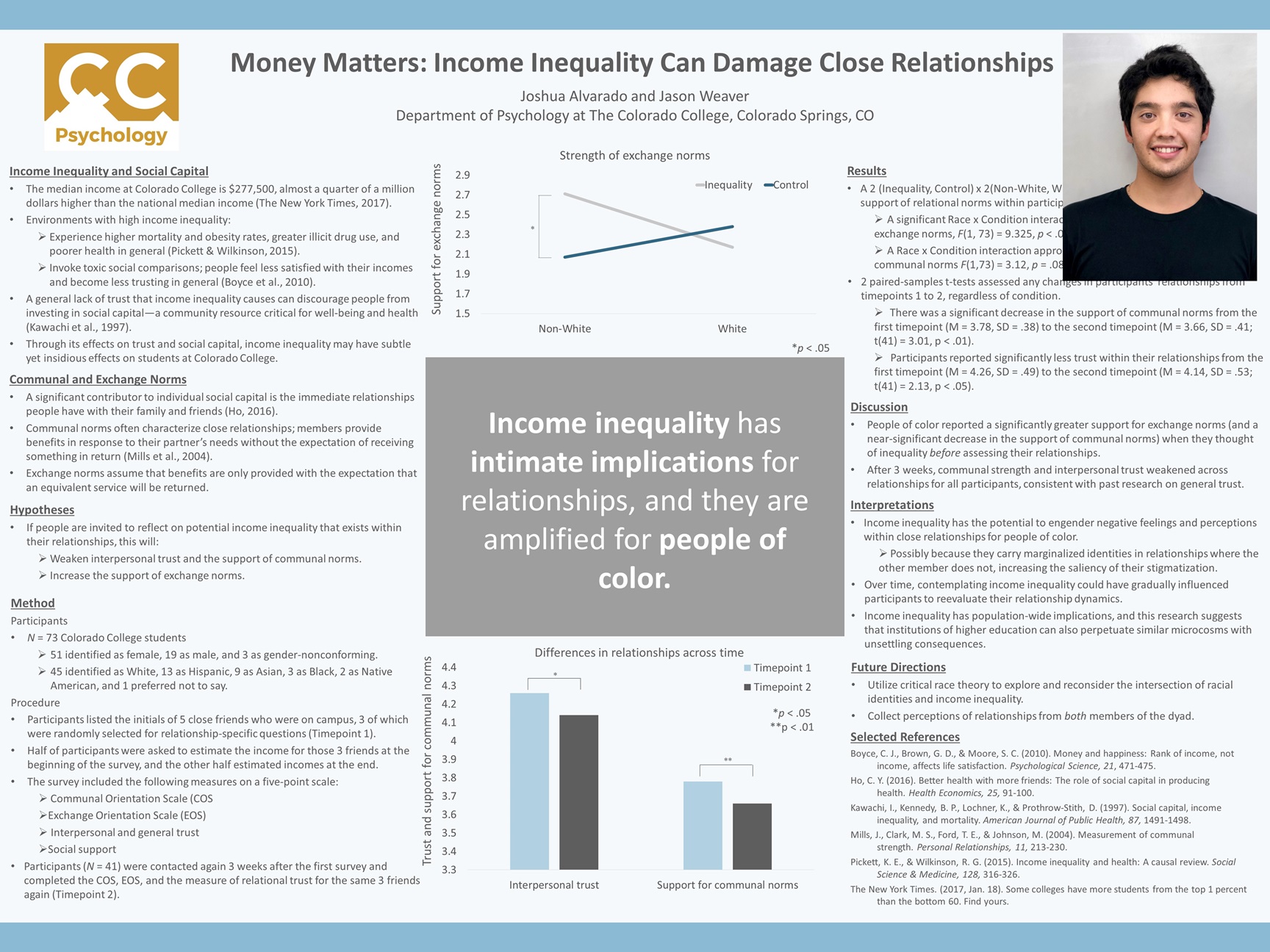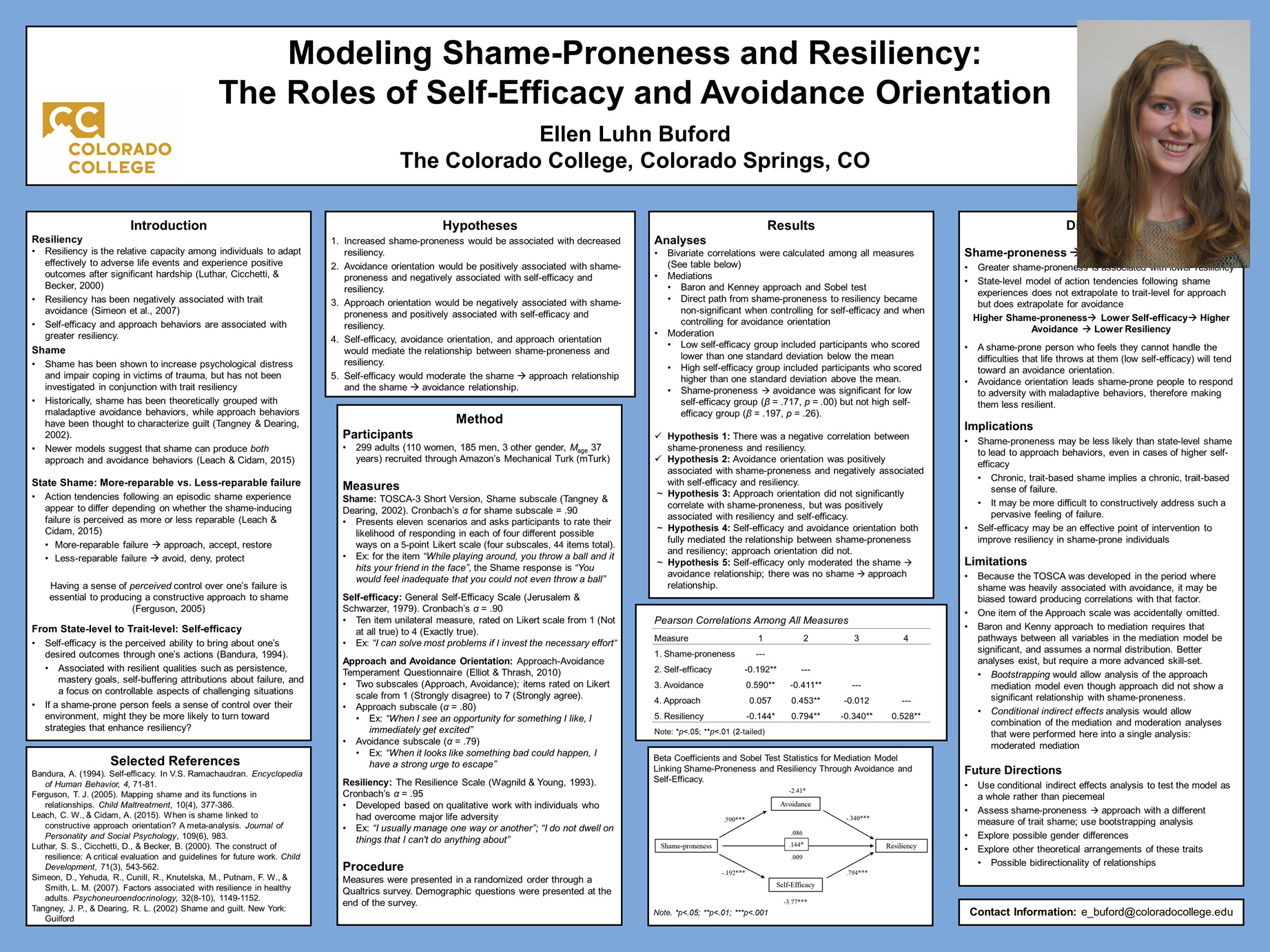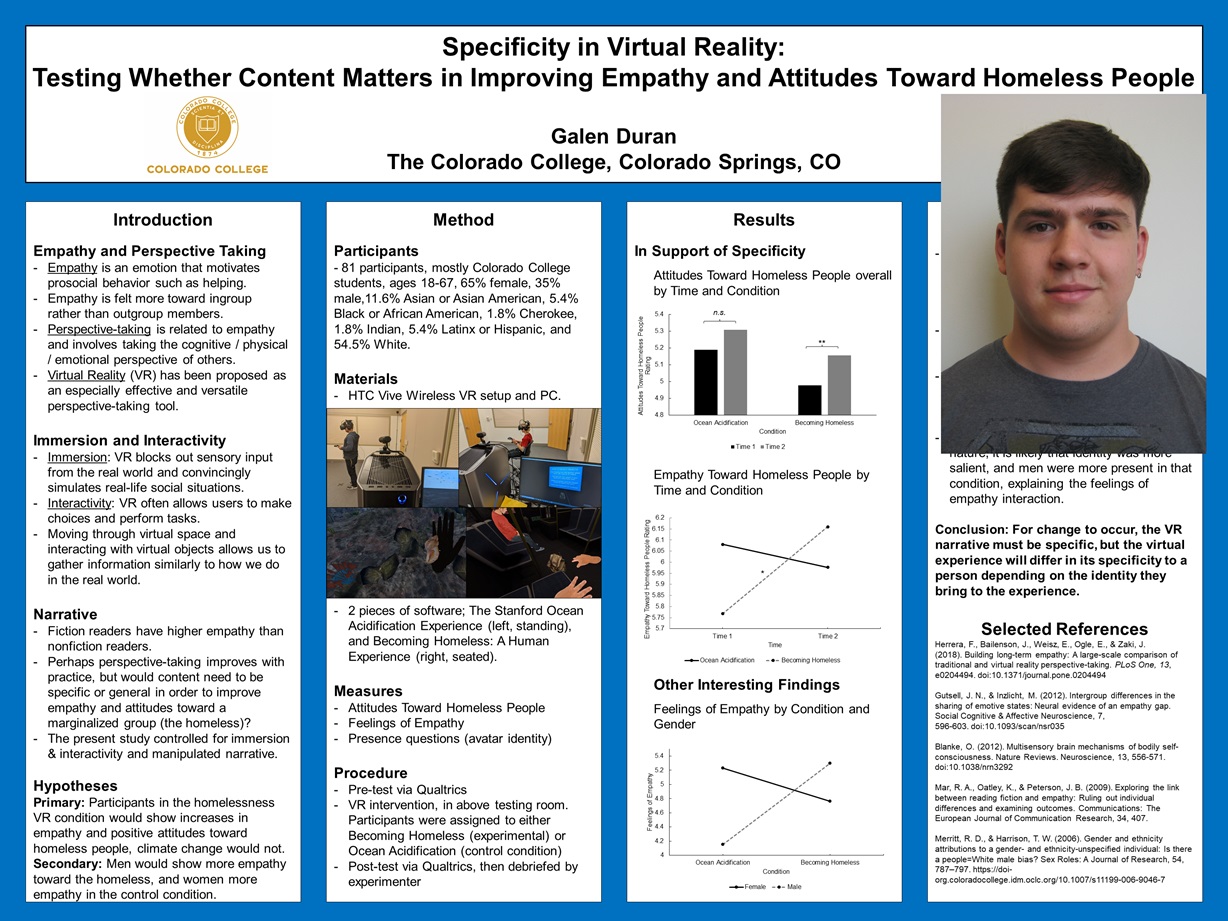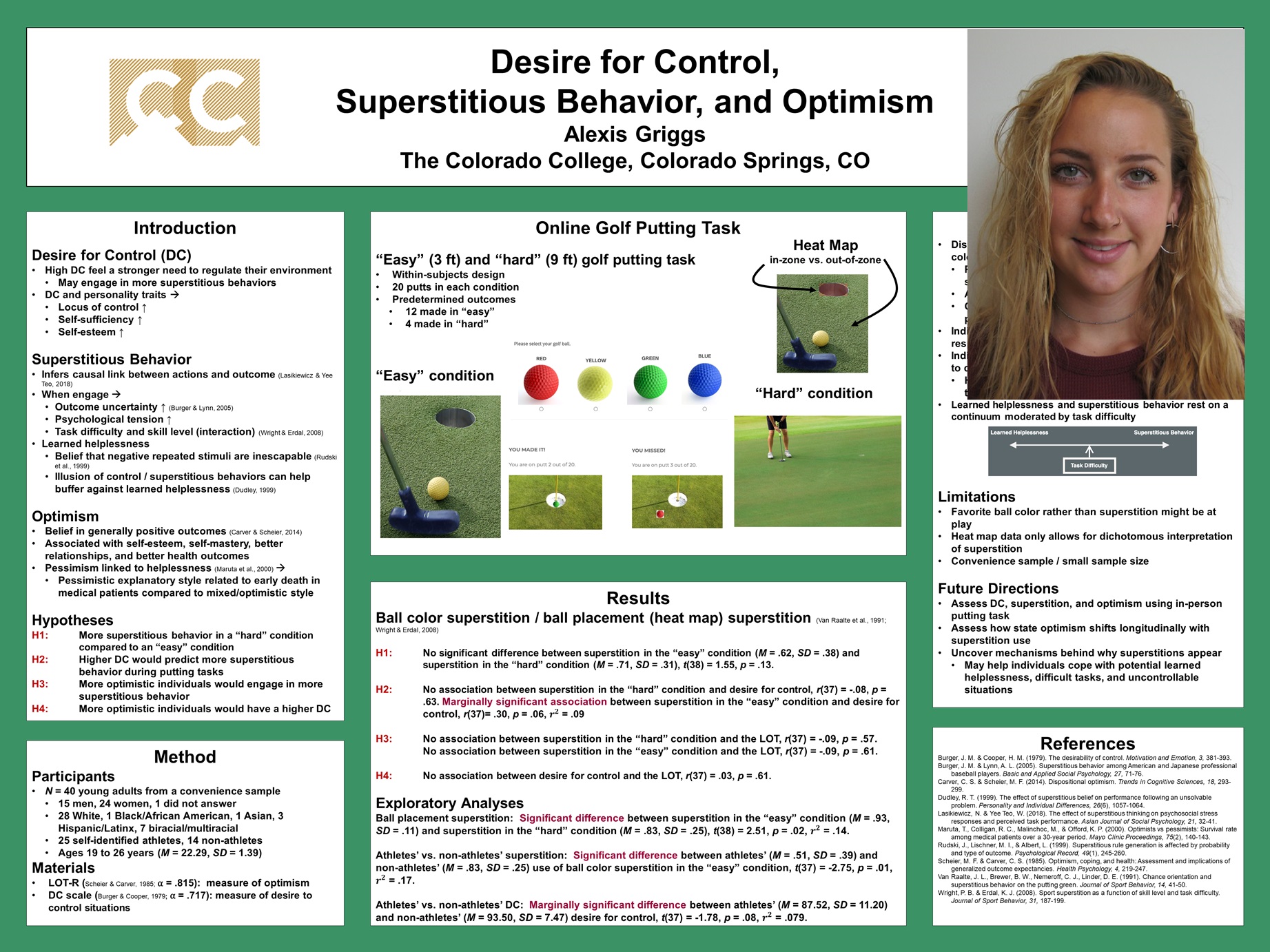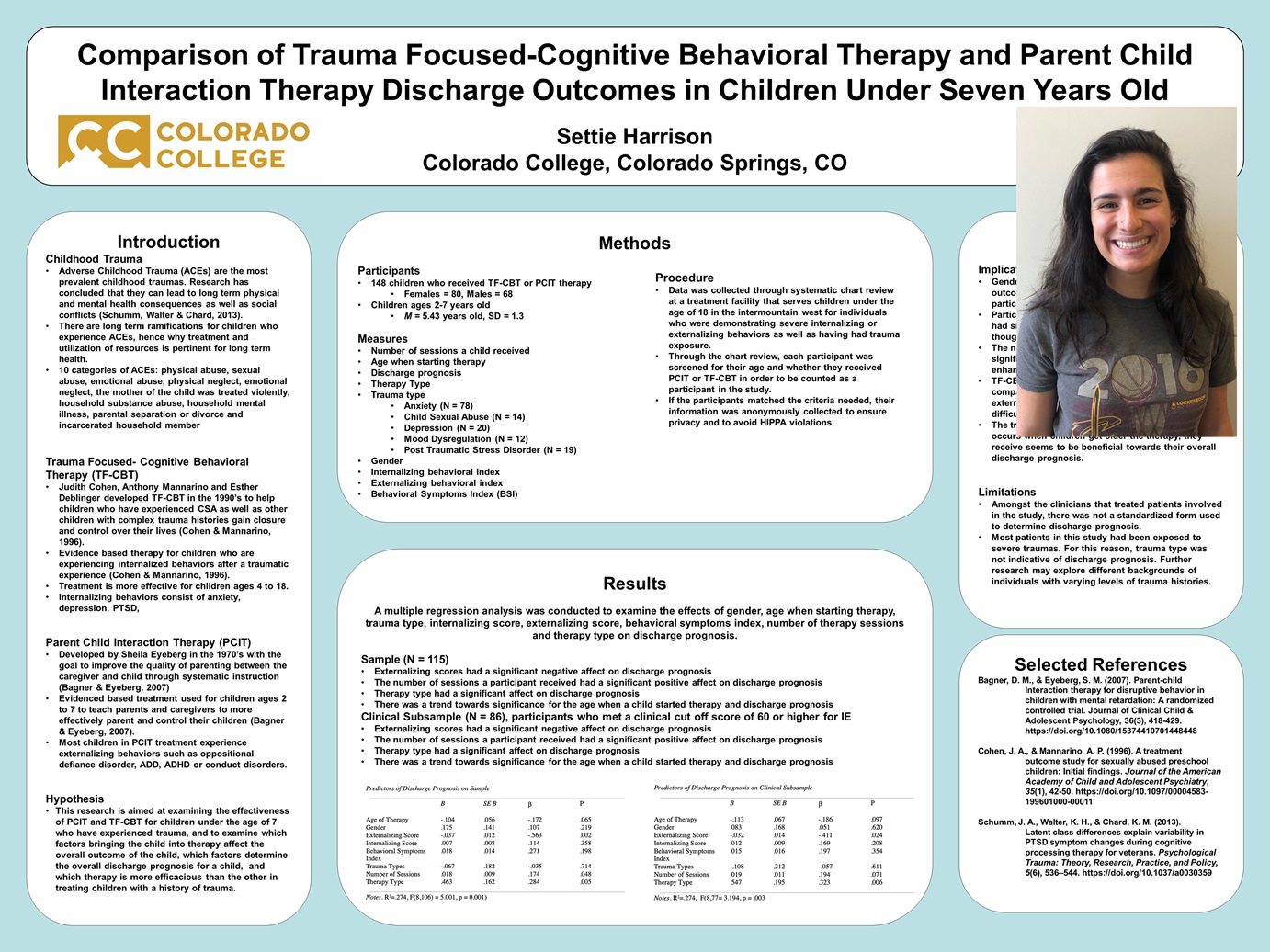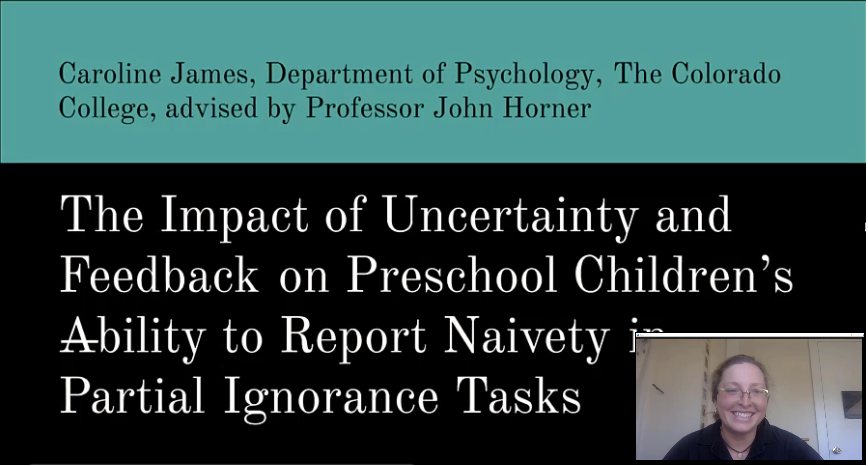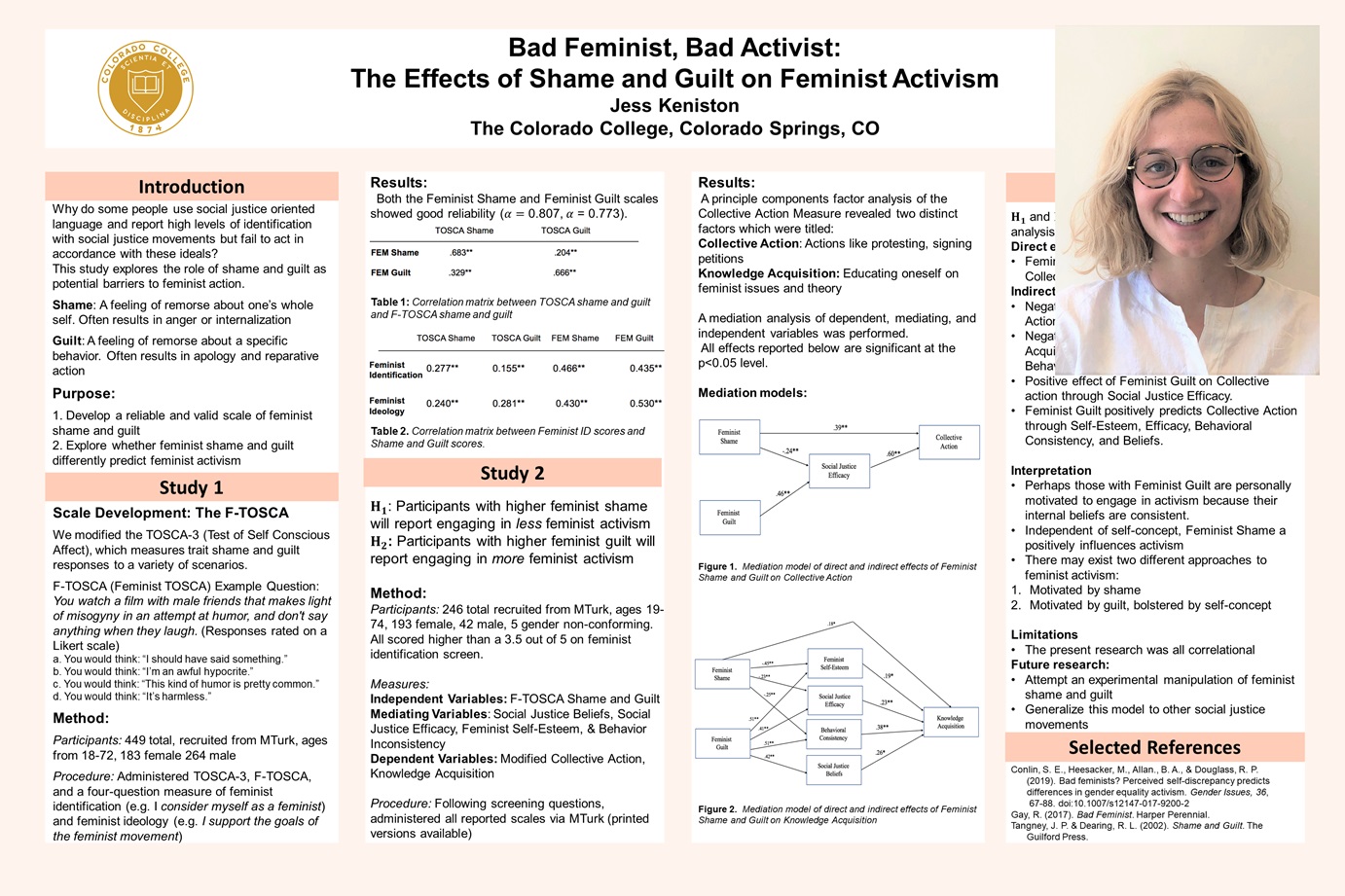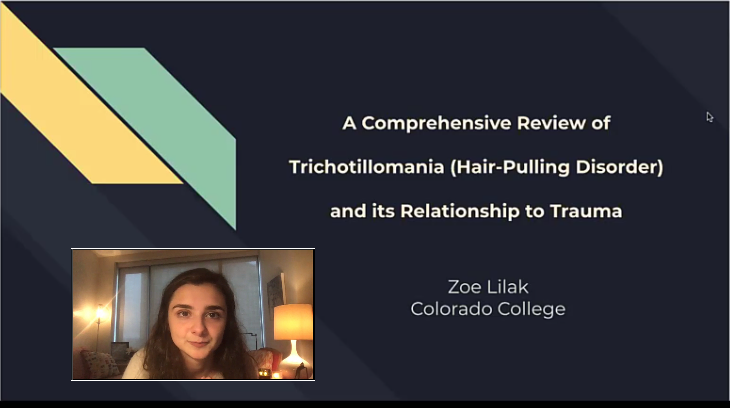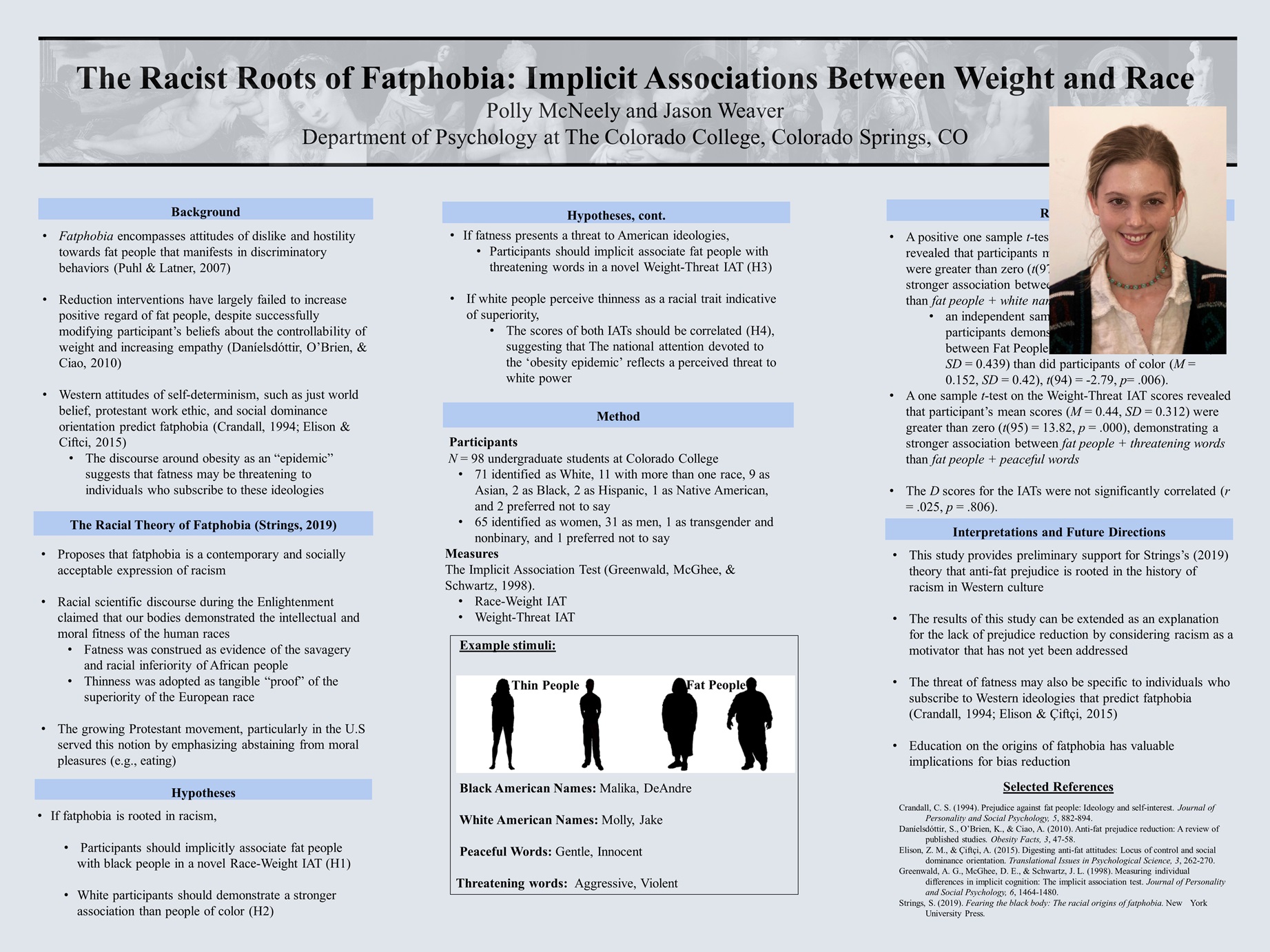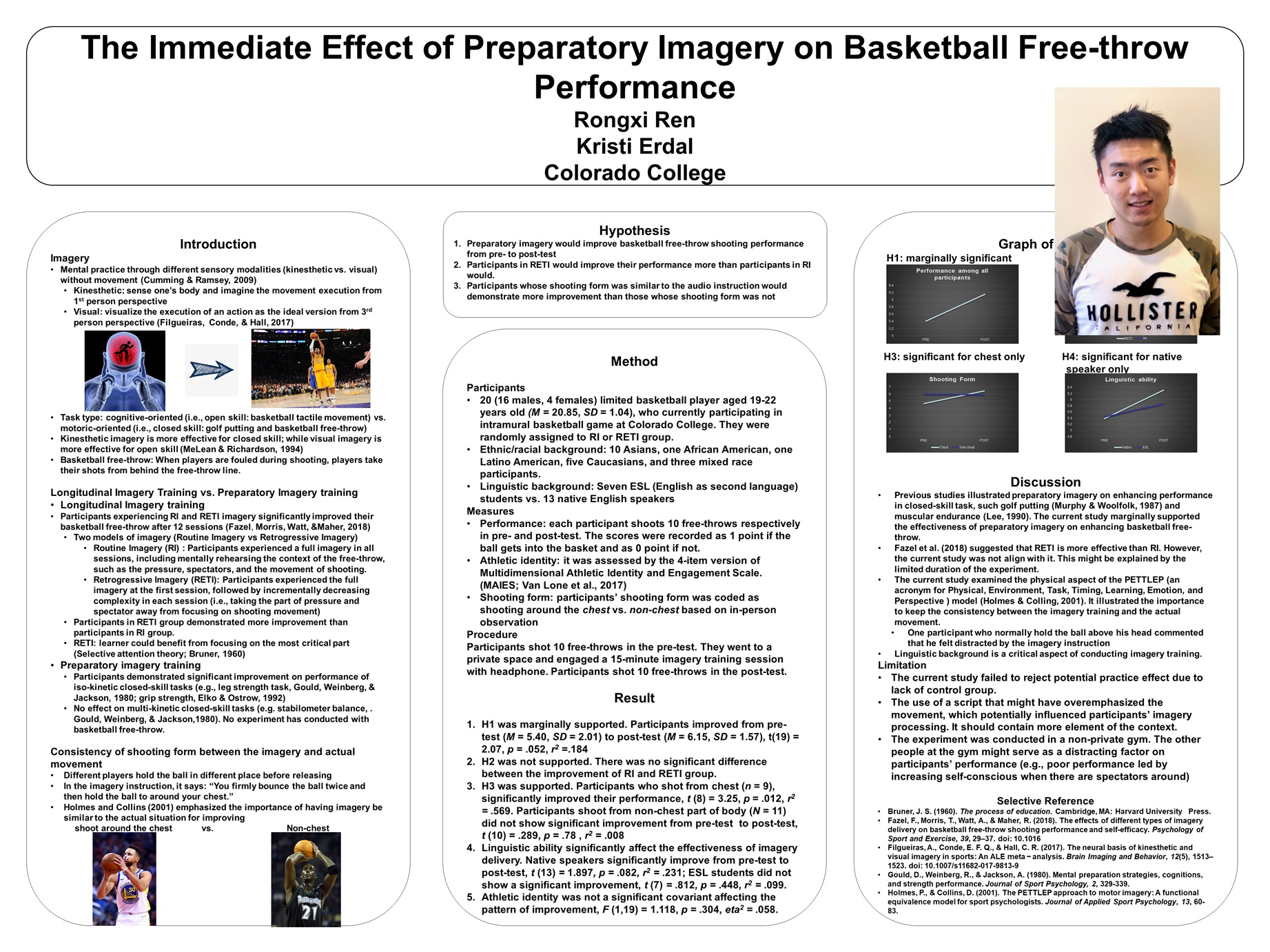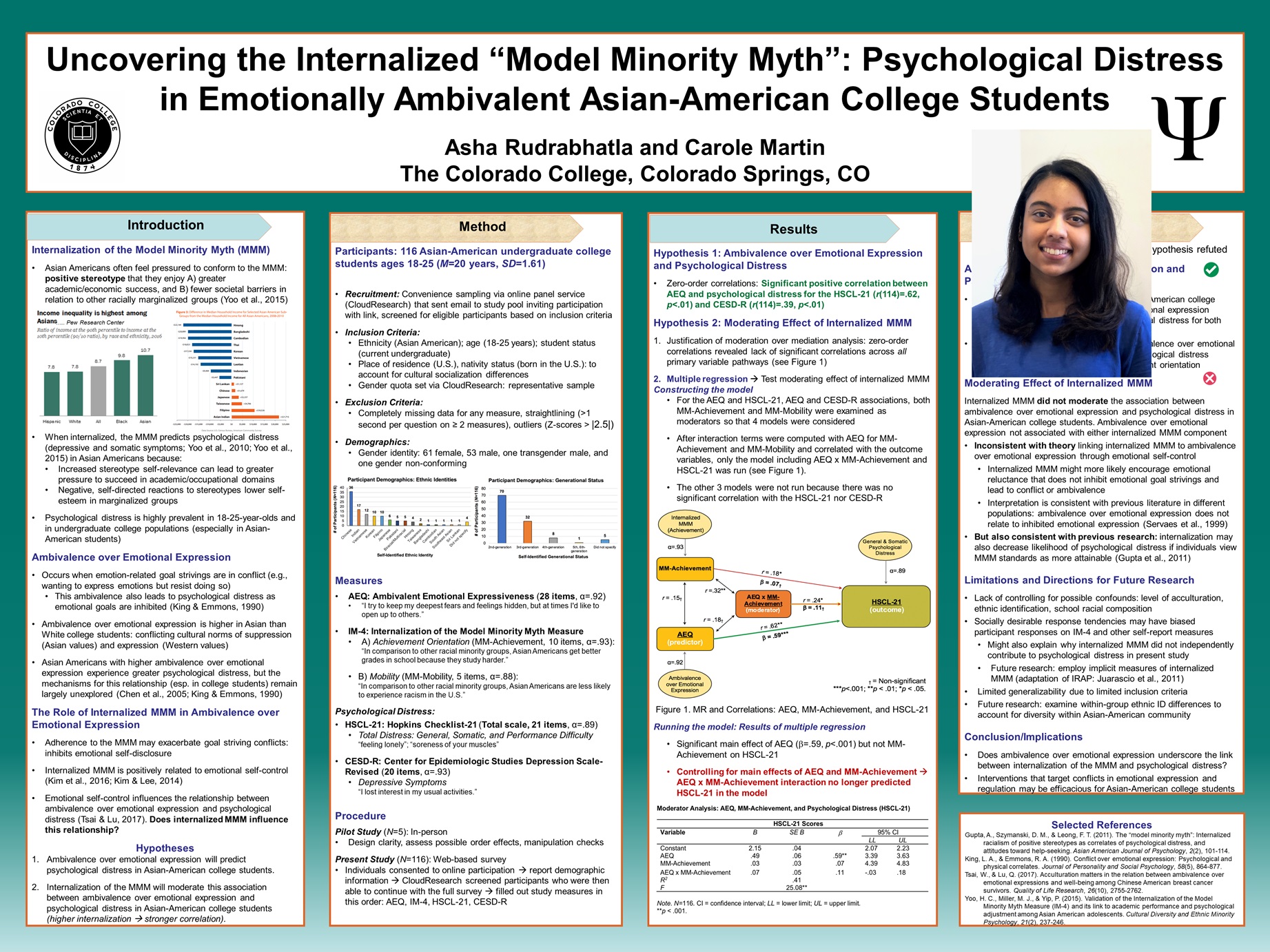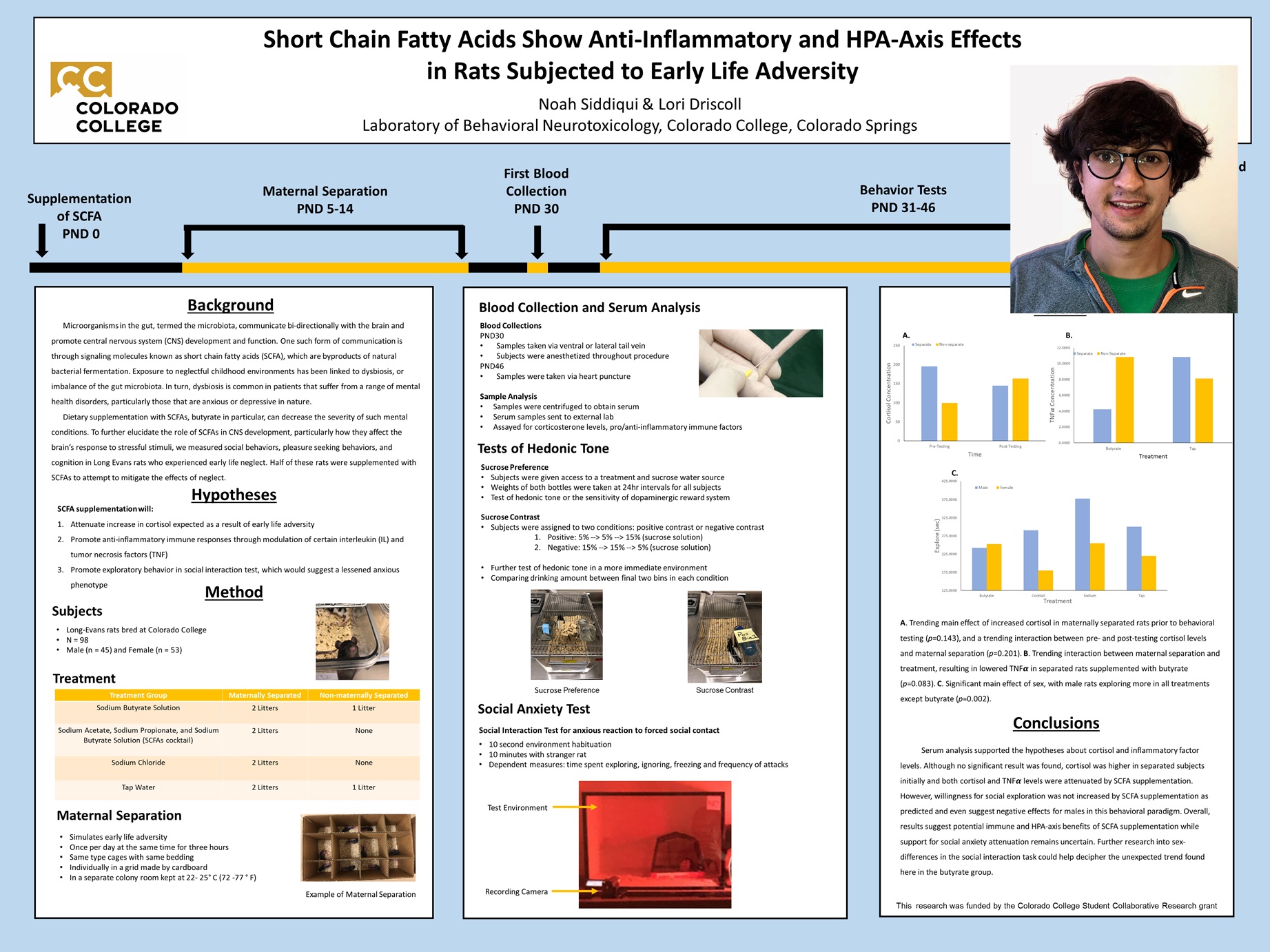Poster Day 2020
Daniel Allen
Psychology
Advisor: Kristi Erdal
Project Talk
Antidepressant-Induced Hypomania
Bipolar disorder is misdiagnosed as major depressive disorder in up to 20-40% of patients, and patients may spend between 5-10 years seeking a correct diagnosis. The prevalence rate of bipolar disorder is also much higher than the “1%” typically reported when less restrictive criteria are used. Misdiagnosis usually leads to an antidepressant prescription, which may have a high risk of inducing mania or hypomania depending on the specific drug or combination of drugs used. Tricyclic antidepressants are associated with the most instances of antidepressant-induced mania, as well as the most severe episodes. Mood stabilizers appear to be generally protective of antidepressant-induced mania, while antipsychotics and anticonvulsants have both antidepressant and anti-manic properties. Paramount in the prevention of antidepressant-induced mania is the early detection of bipolar disorder, which may contribute to a less severe prognosis and better quality of life for the affected patients.
Psychology
Advisor: Jason Weaver
Poster
Income Inequality Can Damage Close Relationships
Populations that live within environments of prominent income inequality have poorer health than individuals who live where wealth is more evenly distributed. Social capital is a potential mediator of this relationship between income inequality and health. I investigated one specific feature of social capital, personal relationships, and whether they could be affected by thinking about income inequality. Specifically, I asked participants to report communal norms, exchange norms, and interpersonal trust within three of their platonic and/or romantic relationships. For people of color, thinking about income inequality induced stronger support for exchange norms within their relationships, indicating that they paid special attention to the interchange of resources between partners. Moreover, asking all participants to reassess their relationships three weeks after I had asked them to think about income inequality revealed that both communal norms and interpersonal trust were weakened in their relationships. Consequently, income inequality may have short-term and long-term effects on relationships, attesting to its insidious role in the degradation of social capital and health.
Psychology
Advisor: Carol Martin
Project Talk
Adolescent Substance Use Disorder: Examining the Efficacy of Prevention and Treatment Methods
The present review evaluates the empirical evidence on emerging and established practices and their potential applicability to the youth population, examining research spanning from 1980 to present. An adolescent-focused model of prevention, treatment, and aftercare is proposed, emphasizing the importance of early intervention and treatment flexibility. Unlike many current treatment models, which focus on life-long abstinence and adhere largely to the unempirical principles of 12-step modalities, incorporates empirical evidence discrediting the notion of abstinence as the only means of intervention for youth, positing that harm reduction approaches may be more accessible and similarly effective as a continued treatment option for the adolescent population.
Psychology
Advisor: Tricia Waters
Poster
Modeling Shame-Proneness and Resiliency: The Roles of Self-Efficacy and Avoidance Orientation
Resiliency is the relative capacity among individuals to adapt effectively to adverse life events and experience positive outcomes after significant hardship. The current research investigated the relationship between shame-proneness and resiliency, and proposed a model wherein self-efficacy and avoidance orientation mediate this relationship. A key theoretical element was the distinction between more-reparable and less-reparable failure as origin points of shame, and the different action tendencies (approach vs. avoid) that are elicited in these two situations. It was theorized that the trajectories of these two possible versions of an episodic shame experience would map onto the relationships of analogous personality traits. Most hypotheses were supported: shame-proneness was shown to have a negative relationship with resiliency, which self-efficacy and avoidance orientation fully mediated. Additionally, self-efficacy moderated the relationship between shame-proneness and avoidance. Methodological limitations, promising points of therapeutic intervention, and directions for future research are discussed.
Neuroscience
Advisor: Lori Driscoll
Poster
Postnatal Short Chain Fatty Acid Supplementation to Mitigate Behavioral Effects of Maternal Separation in Rats
Thousands of species of microorganisms in our gut, including bacteria, fungi, and viruses, collectively make up our gut microbiota. Some of these organisms, particularly probiotic (beneficial) bacteria, produce the short chain fatty acids (SCFA) acetate, propionate, and butyrate, which can communicate with the host’s brain. In particular, butyrate seems to provide vital signals for successful brain development. However, adverse events such as childhood neglect can produce an imbalance in gut microbiota that may lead to broad and lifelong impacts on mental health, increasing susceptibility to depression, anhedonia, and autism spectrum disorders. The goal of the current study was to explore the potential beneficial effects of early postnatal SCFA supplementation on alleviation of developmental adversity. Newborn rats were administered an SCFA cocktail, butyrate alone, sodium chloride alone, or plain tap water through their dam’s drinking water, and then in their own drinking water. From postnatal days 5-15, the pups experienced maternal separation, a model for childhood neglect. As juveniles, the rats were administered several behavior tests, including the Open Field (OF) test for anxiety; the Morris Water Maze (MWM) test for spatial memory; the Sucrose Preference test and the Sucrose Contrast test for depression; the Social Preference test; and the Social Interaction test for sociability. We hypothesized that the rats supplemented with SCFAs would receive a buffer effect against the negative influence of maternal separation. However, our results showed that SCFAs supplementation increased anxiety and failed to enhance spatial memory when compared to non-supplemented rats.
Independently Designed Major
Advisor: Kevin Holmes
Project Talk
"Girls are as good as boys" Implies Boys are Better, but Only in the Absence of Explicit Awareness
The statement “girls are as good as boys at math” appears to express that girls and boys are equally skilled, but research indicates that such subject-complement statements subtly imply that the group in the complement position (boys) is superior. Even when people hold baseline stereotypes about the domain in question, their judgments of ability can still be swayed by reading such a statement. In three experiments, we investigated the effects of explicit awareness of this kind of syntax in regard to math ability and likelihood of being a terrorist. Participants read a passage describing a large-scale study about either math or terrorism that contained such subject-complement sentences and then judged either which gender (girls or boys) was more skilled at math or which religious group (Christians or Muslims) was more likely to be terrorists. By replicating and extending previous work, we found that those who do not explicitly attend to the subject-complement syntax make judgments in line with the implied biases. Those who do explicitly attend to the syntax either show a bias in the opposite direction or none at all, perhaps because they consciously resist the subtle biases. Our results suggest that effects of these statements on judgments of ability and disposition are not as pervasive as previously assumed.
Psychology
Advisor: Tomi-Ann Roberts
Poster
Specificity in Virtual Reality: Testing Whether Content Matters in Improving Empathy and Attitudes Toward Homeless People
The present study was an extension of Herrera, Bailenson, Weisz, Ogle, and Zaki (2018), using a pre-post experimental design to test the effects of Virtual Reality (VR) perspective-taking tasks on improving attitudes and empathy toward marginalized groups. The design compared an experimental homelessness experience to a control climate change experience to investigate whether VR content must be specific to a relevant social group, or whether it is a generalized tool for garnering prosocial benefits. Results largely supported the hypothesis that content must be specific to the group in question, with participants in the homelessness condition reporting significant increases in empathy and positive attitudes toward homeless people compared to those in the climate change condition. Unexpected findings included women and people of color showing less identification with their avatar in the homelessness condition compared to men and white people. Surprisingly, the intervention did not decrease accessibility of stereotypes or increase self-other overlap, suggesting that VR perspective-taking tasks may work more at an emotional than a cognitive level to improve attitudes and empathy toward marginalized groups.
Psychology
Advisor: Tomi-Ann Roberts
Poster
The Online Body Economy: How Picture-Based Social Media Shapes Feminist Solidarity and Activism
These studies investigated the role of picture-based social media use on young women’s intra-gender attitudes and attitudes towards the body, and in turn their effects on gender-based collective action. Two different samples of women aged 18 to 34 completed surveys on Amazon Mechanical Turk. Results from Study 1 showed that Instagram use was positively associated with both empathy for and hostility toward other women. Results from Study 2 replicated previous research, showing a negative effect of Instagram use on collective action through self-objectification. Unexpectedly, two additional positive pathways to collective action were found: one from Instagram investment through belief in beauty as currency and the other from solidarity through beauty as currency. Implications for young women’s Instagram use and belief in beauty as currency as predictors of activism are discussed.
Psychology
Advisor: Kristi Erdal
Poster
Desire for Control, Superstitious Behavior, and Optimism
Superstition suggests a causal link between an individual’s behavior and outcome, when no link actually exists. Previous research suggests that superstition is associated with an individual’s desire for control, but its relationship with optimism has shown mixed results. The current study assessed individuals’ superstitious behaviors by ball color choice and ball placement during an online putting task, split into “easy” and “hard” conditions with predetermined outcomes, and measured optimism and desire for control. Results indicated a marginally significant relationship between desire for control and superstitious ball color choice in the “easy” condition, while there was no association in the “hard” condition. Ball placement data during the putting tasks revealed a significant difference between placement superstition in the “easy” condition versus the “hard” condition, suggesting that individuals were proportionally more likely to place their ball in the same area following a made putt in the “easy” condition than in the “hard” condition. These findings suggest that individuals with a higher desire for control may engage in more superstitious behaviors, even when they were unaware of how much control they had over the situation, and provides further evidence for learned helplessness and superstitious behavior falling on a continuum moderated by task difficulty.
Psychology
Advisor: Tricia Waters
Poster
Comparison of Trauma Focused-Cognitive Behavioral Therapy and Parent Child Interaction Therapy Discharge Outcomes in Children Under Seven Years Old
This study focused on children who were participants in therapy at a treatment facility in a mid-sized city in the western United States. The data were collected through chart review. The goal was to determine whether or not there are any factors that determine discharge prognosis for children under the age of 7 participating in Parent Child Interaction Therapy (PCIT) or Trauma Focused Cognitive Behavioral Therapy (TF-CBT). Through a multiple regression analysis of all participants, it was found that increased externalizing behaviors, the number of sessions a child received, and the therapy type they received all affect discharge prognosis. There was a trend towards significance of age. With a clinical cut off score of above 60 in internalizing and externalizing scores, it was determined that increased externalizing scores, number of sessions, and therapy type remained significant on discharge prognosis. The outcome of the participants was significant in terms of determining that TF-CBT works to treat more than just CSA and has significant outcomes.
Psychology
Advisor: John Horner
Project Talk
The Impact of Uncertainty and Feedback on Preschool Children’s Ability to Report Naivety in Partial Ignorance Tasks
Previous research suggests that, before age six, children generally do not report to adults when they do not know something. The significance of this finding increases when the condition is a partial ignorance task in which the children only have access to part of the correct answer. It is possible in these tasks children are actually assessing their personal probability of knowing the correct answer and responding accordingly. There is little empirical support for this explanation, however. This study measured the effects of a feedback condition in an ABA design of preschool-aged children’s willingness to tell a researcher that they did not know the answer to a question, while manipulating the probability of the children knowing the correct answer. Both the feedback and probability manipulation factors had an effect on children’s likelihood of indicating “I don’t know,” although the significance for the feedback condition was in the opposite direction from predicted.
Psychology
Advisor: Tomi-Ann Roberts
Poster
Bad Feminist, Bad Activist: The Effects of Shame and Guilt on Feminist Activism
A strong connection to a progressive movement, coupled with a failure to embody its ideals, can lead to doubt. This study investigated the impact of the feelings of shame and guilt about one’s feminist behaviors on participation in feminist activism. The self-conscious emotion of guilt is theorized to predict reparative action, whereas shame often results in withdrawal, anger, or an attempt to repair one’s image. We hypothesized that those who feel guilt about transgressions relevant to gender equity would engage in more activism, whereas those who feel feminist shame would participate less. Our first study created and validated the F-TOSCA, a measure of feminist shame and guilt based on Tangney and Dearing’s (2002) TOSCA-3 (Test of Self-Conscious Affect). Our second study tested the distinct ways that feminist shame and guilt predict activism. Results indicated that feminist guilt is positively associated with activism, mediated by a positive view of oneself as a feminist. Feminist shame also predicted activism, but through a negative evaluation of the self as a feminist.
Psychology
Advisor: Carol Martin
Project Talk
A Comprehensive Review of Trichotillomania (Hair-Pulling Disorder) and its Relationship to Trauma
The present review focuses on a psychiatric disorder known as trichotillomania (TTM), which has the primary characteristic of recurrent pulling of one’s own hair. The review explores the association between TTM and trauma through examining the following TTM topics: classification, diagnostic criteria, etiology, neuroscientific research, psychological effects, evidence pertaining to its relationship with trauma, and treatment options. The review is based on a critical examination of 31 resources (journal articles, academic books, various versions of the Diagnostic Statistical Manual) published from 1973 to 2019. Evidence that TTM may be best treated using habit reversal training (HRT), HRT supplemented with metacognitive therapy, or “nontraditional” forms of group therapy found online or through the Trichotillomania Learning Center. Moreover, evidence suggests the existence of an association between TTM and trauma, although additional research must be conducted to confirm such a relationship.
Psychology
Advisor: Jason Weaver
Poster
The Racist Roots of Fatphobia: Implicit Associations Between Weight and Race
Anti-fat prejudice, popularly known as fatphobia, is widespread and rapidly increasing, inflicting harm on individuals of all body sizes. Previous research attempting to reduce this prejudice has been largely unsuccessful. This study sought to empirically investigate the sociological theory that fatphobia is rooted in racism. Strings (2019) highlights racial Enlightenment-era discourse which claimed that our bodies demonstrated the intellectual and moral fitness of the human races. Fatness was construed as evidence of the savagery and racial inferiority of African people. This study found that white participants cognitively associated fat people with black people on a Weigh-Race Implicit Association Test, offering preliminary evidence in support of String’s (2019) theory. Future research clarifying the causal nature of this claim has incredibly valuable implications for the reduction of fatphobia.
Independently Designed Major
Advisor: Kevin Holmes
Project Talk
Does Local Topography Affect Navigation Heuristics? Assessing the Southern Route Preference in a Novel Environment
Navigators tend to select south-going routes over equally long north-going ones—a southern route preference that has been attributed to an implicit association between north and mountainous terrain. Previous research has documented the southern route preference even in environments with higher elevations to the south, suggesting that the preference is not due to regional elevation patterns. We further tested for an influence of such patterns by investigating route planning in participants who reside in an environment with higher elevations to the west, in whom an eastern preference might be expected. We found that participants were no more likely to select east-going than west-going routes, but their route choices replicated the well-established southern preference. Our results provide further evidence that this preference is driven by map-induced associations between cardinal direction and topography, rather than by the local topography of the surrounding environment.
Psychology
Advisor: Emily Chan
Project Talk
Cross-Cultural Examination of Infrahumanization: Immigrants in Italy and U.S.
The presence of ingroup vs. outgroup distinctions can result in a subtle form of dehumanization—infrahumanization—where people of a given outgroup are not afforded the ability to feel uniquely human emotions. The current studies investigated if the portrayal of outgroup immigrants with uniquely human emotions (secondary emotions) vs. with primary emotions would impact perceivers’ inferences about immigrants. In study 1 and study 2, participants read one of three immigration news stories from their respective country (Italy or the United States) that described the immigrants using no emotional descriptions, primary emotions (e.g., “frantic and anxious”), or secondary emotions (e.g., “overwhelmed and a sense of despair”). Participants were then asked to suggest a solution to the immigration issue, asked about their attitudes towards immigrants, and about their perceived intergroup threat from immigrants. The findings demonstrated that in the United States primary emotional framing (infrahumanization) in the news story led to higher levels of symbolic threat. Surprisingly, it was also found that those who read the secondary emotional framing in the news story were more likely to support enforcement as a solution to the problems of the immigration system. There were no significant effect of the manipulation for the Italian population. These results suggest the need to broaden investigation of news media and its consequences for the immigration system.
Psychology
Advisor: Kristi Erdal
Poster
The Immediate Effect of Preparatory Imagery on Basketball Free-throw Performance
The purpose of this study was to investigate the effect of the preparatory imagery program among Colorado College intramural basketball players over a one-session imagery training. The study compared the efficacy of two imagery training methods: routine imagery (unchanged imagery during the session) and retrogressive imagery (starting with fully detailed imagery then removing contextual factors). A within-subject design was employed in which participants were randomly assigned to one of two imagery training methods: routine imagery (n = 9) and retrogressive imagery (n = 11). Free-throw data were collected before and after the imagery training. Besides the imagery training methods, the results were compared between shooting forms (chest shooting vs. non-chest shooting) and linguistic backgrounds (English as second language speakers vs. native English speakers). Athletic identity was also examined as a covariate in the data analysis. A marginally significant improvement was found among all participants but no significant difference was found between imagery training methods. The split file analysis between shooting form showed that participants who shot from chest improved significantly more than those who shot from non-chest parts of the body. It was because the imagery training instructed participants to hold the ball at the chest and then shoot. The split file analysis between linguistic backgrounds demonstrated that native English speakers enhanced their performance more than ESL speakers. Athletic identity was not a significant factor affecting performance enhancement. The study concludes that preparatory imagery was marginally efficient in improving the performance of a complex closed task, the basketball free-throws shooting. To maximize the efficacy of the imagery, it is important to ensure the similarity between the imagery and actual movement, and participants’ linguistic backgrounds.
Psychology
Advisor:Carole Martin
Poster
Uncovering the Internalized “Model Minority Myth”: Correlates of Psychological Distress in Emotionally Ambivalent Asian-American College Students
The model minority myth is the positive stereotype that Asian Americans enjoy greater academic success and fewer societal barriers in comparison to other racially marginalized groups. However, Asian Americans who internalize the model minority myth experience high rates of psychological distress. Ambivalence over emotional expression, which is more prevalent in Asian Americans, has also been shown to contribute to the elevated rates of psychological distress in this population. Although psychological distress is especially high in college students, the mechanisms underlying the relationship between ambivalence over emotional expression and psychological distress in Asian-American college students remain largely unexplored. The present correlational study examined the moderating effect of internalized model minority myth in the relationship between ambivalence over emotional expression and psychological distress in Asian-American college students (N=116). Participants completed measures for each of the study variables through an online survey disseminated by a panel service. A multiple regression moderation analysis revealed that ambivalence over emotional expression significantly predicted psychological distress independent of internalization of the model minority myth, which did not moderate this relationship. These findings suggest the clinical importance of examining ambivalence over emotional expression when considering the relationship between internalization of the model minority myth and psychological distress in Asian Americans.
Psychology
Advisor: Lori Driscoll
Poster
Short Chain Fatty Acids Show Anti-Inflammatory and HPA-Axis Effects in Rats Subjected to Early Life Adversity
The microorganisms in your gut, collectively termed the microbiota, communicate bi-directionally with the brain and promote central nervous system (CNS) development and function. One such form of communication is through signaling molecules known as short chain fatty acids (SCFA), which are byproducts of natural bacterial fermentation. Exposure to neglectful childhood environments has been linked to dysbiosis, or imbalance of the gut microbiota. In turn, dysbiosis is common in patients that suffer from a range of mental health disorders, particularly those that are anxious or depressive in nature. Dietary supplementation with SCFAs, butyrate in particular, can decrease the severity of such mental conditions. To further elucidate the role of SCFAs in CNS development, particularly how they affect the brain’s response to stressful stimuli, we measured social behaviors and pleasure seeking behaviors in Long Evans rats that experienced early life neglect. Half of the subjects were supplemented with SCFAs to attempt to mitigate the expected negative effects of early life neglect.
Psychology
Advisor: Kristi Erdal
Project Talk
The Cultural and Genetic Influences on Neuromorphology
Individuals, being from varying biological, cultural, and behavioral backgrounds, all develop distinctly. However, there are patterns of behavior, genetic expression, and cultural norms that explain global trends of development on the individual scale. Individualism and collectivism are two foundational, diametric concepts relating respectively to independent and interdependent self-construals and suggest that personal traits and neurological differences may be more explainable by culture than previously thought. Informing cross-cultural psychology, gene-culture coevolution theory reveals that genes and culture evolve together and inform each other, potentially creating distinct morphological, neural, as well as social patterns in groups of people globally. The specific feature of psychopathology is investigated to demonstrate those interactions.
Psychology
Advisor: Emily Chan
Project Talk
White Fragility: Constructing a Psychologically Valid New Scale
The concept of White fragility has been increasingly popular both in the media and applied settings due to Robin DiAngelo’s bestseller, “White Fragility: Why It’s So Hard for White People to Talk About Racism”. White fragility is best described by the defensive feelings, justifications and behaviors displayed by White people when confronted with their responsibility and role in upholding racism. The purpose of this study was to develop a scale that measured White fragility on a social psychological level, identifying the components of the experience of White fragility. The new White Fragility Scale we created has three subscales: an affective component, a motivational component related to self-concern, and a cognitive component of beliefs that justifies racism. Results confirmed that not only do these subscales relate to each other and depict a psychological representation of White fragility, but certain dimensions of White fragility also predict related concepts in racism, such as emotion regulation and self-efficacy.
Neuroscience
Advisor: Lori Driscoll
Project Talk
Drug Viability in Crustacean Models via Vapor Administration
Previous research has demonstrated that crustaceans are viable subjects in drug addiction research using intravenous administration. However, with the increasing use and abuse of vaporized drugs, the model will need to be altered to account for the unique pharmacokinetic properties of vaping. This updated model is needed to explore the bases of the increase in e-cigarette, or vaping, product use-associated lung injury (EVALI) cases, which in several instances has resulted in death among adolescents. While vapor drug administration has been tested in vertebrate models, it has been sparingly tested in invertebrates, and never before in crustaceans. Although crustaceans do not have lungs, their easily identifiable neural circuits make them prime subjects in the exploration of vapor administered drug effects. This study aimed to test the viability of vapor administration in crustaceans using tetrahydrocannabinol (THC), methamphetamine, and oxycodone, each of which were administered in combination with PG. Subjects were placed in a sealed chamber, with crayfish undergoing 20 minute sessions and lobsters undergoing 30 minute sessions. To test if the drug was successfully administered, crayfish were tested in several locomotor assays, and lobsters were tested for nociception by dipping their appendages in warm water. While no significant drug effect was found in this study, individual animal responses suggested that with improvement of the protocol, crustaceans could be a valuable resource in the researching of the increasingly popular vapor administration of drug.
Riri Uchida, Coby Dodelson, Hyunsoo Shin
Neuroscience
Advisor: Bob Jacobs
Project Talk
Quantitative Analysis of Dendritic Decline Associated with Chronic Traumatic Encephalopathy
Repetitive head impacts (RHI) may be a major risk factor for the neurodegeneration associated with chronic traumatic encephalopathy (CTE). Although the enduring neural effects of CTE (e.g., tau pathology, gross atrophy) have been extensively investigated (McKee et al., 2009, 2015; Omaluet al., 2011), there are no microscopic investigations into chronic CTE related morphological changes in cortical dendritic systems. The present study quantifies the potential long-term effects of RHI on the dendritic systems of supragranularpyramidal neurons in the frontal and occipital poles in CTE. Samples were obtained from the frontal and occipital poles of 11 humans diagnosed with CTE following sports-related RHI (Mage= 79 ± 2.23 years) and compared to tissue from five neurologically normal individuals (Mage= 76 ± 5.01 years). Tissue was prepared using a modified rapid Golgi technique, with 20 neurons sampled from each cortical region (N = 640). Dendritic arbors were analyzed using computer-assisted morphometry. Quantitative dendritic and spine measures tended be lower in all CTE tissue compared to controls. This decrease was observed in both cortical regions, with neurons in the prefrontal cortex appearing to be more severely affected than those in the visual cortex. In the frontal pole, basilar dendritic branches showed the greatest decrease in volume whereas apical branches showed the greatest decline in length. These group differences in the frontal lobe were more pronounced in distal than in proximal basilar dendritic segments. Finally, changes in dendritic diameter suggest that volumetric dendritic degeneration may precede length-wise degeneration. Such dendritic declines following RHI, which may be amplified by the presence of the tau pathology in CTE, may have negative implications for cognitive functioning.
Psychology
Advisor: Kevin Holmes
Project Talk
Abstract Yet Specific: Why Affect Labeling Dampens Emotional Experience
Affect labeling has been shown to be an effective strategy for emotion regulation, but few studies have explored which properties of affect labels drive their effectiveness. Here I propose that the most effective affect labels are those that are both abstract and emotionally specific. Across two high-powered preregistered experiments, I investigated this proposal by comparing participants’ self-reported distress after passively watching aversive images or labeling the same images with basic emotion words (e.g., sad) which possess both abstractness and emotional specificity, abstract emotion words (e.g., adversity) which possess only abstractness, or object words (e.g., eyes) which possess only emotional specificity. As predicted, basic emotion words were the only labels to yield significant distress reduction compared to the passive watch condition. Moreover, when asked explicitly, participants failed to predict the effectiveness of basic emotion words compared to other affect labels, expecting that abstract emotion words would yield the greatest distress reduction. In addition, participants who reported having trouble identifying and describing their feelings benefited less from affect labeling with basic emotion words and were aware of this reduced benefit. These findings have implications for several candidate mechanisms of affect labeling, as well as applications in clinical settings. I provide suggestions for future research to further explore the properties of affect labels that make them effective.
show all / hide all



